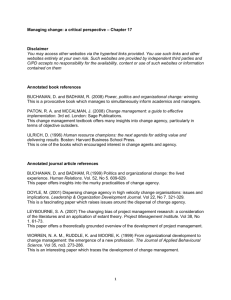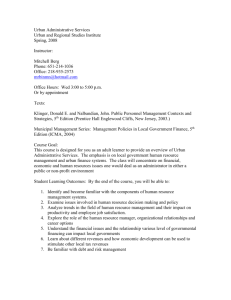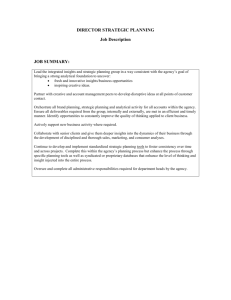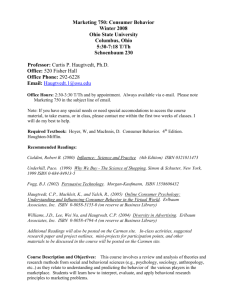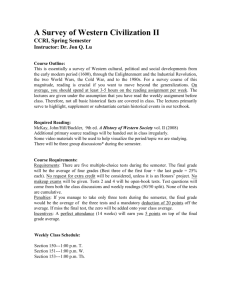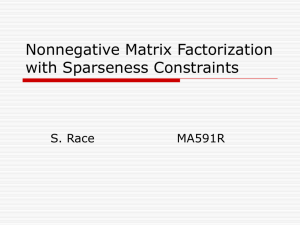NUS
advertisement
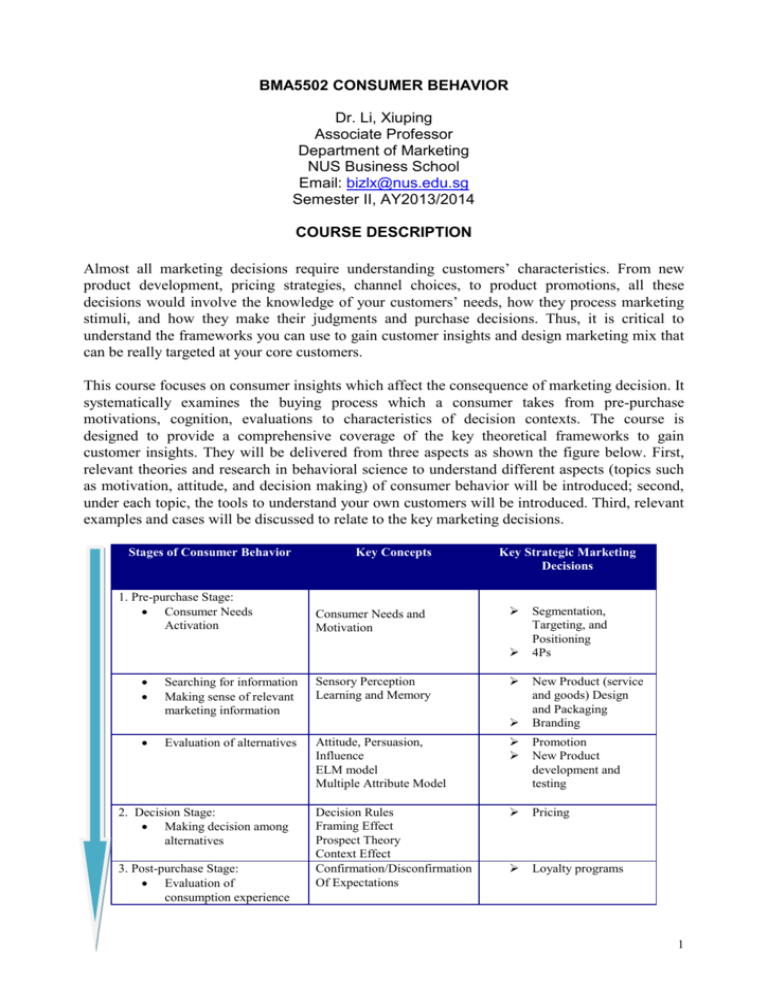
BMA5502 CONSUMER BEHAVIOR Dr. Li, Xiuping Associate Professor Department of Marketing NUS Business School Email: bizlx@nus.edu.sg Semester II, AY2013/2014 COURSE DESCRIPTION Almost all marketing decisions require understanding customers’ characteristics. From new product development, pricing strategies, channel choices, to product promotions, all these decisions would involve the knowledge of your customers’ needs, how they process marketing stimuli, and how they make their judgments and purchase decisions. Thus, it is critical to understand the frameworks you can use to gain customer insights and design marketing mix that can be really targeted at your core customers. This course focuses on consumer insights which affect the consequence of marketing decision. It systematically examines the buying process which a consumer takes from pre-purchase motivations, cognition, evaluations to characteristics of decision contexts. The course is designed to provide a comprehensive coverage of the key theoretical frameworks to gain customer insights. They will be delivered from three aspects as shown the figure below. First, relevant theories and research in behavioral science to understand different aspects (topics such as motivation, attitude, and decision making) of consumer behavior will be introduced; second, under each topic, the tools to understand your own customers will be introduced. Third, relevant examples and cases will be discussed to relate to the key marketing decisions. Stages of Consumer Behavior 1. Pre-purchase Stage: Consumer Needs Activation Key Concepts Consumer Needs and Motivation Key Strategic Marketing Decisions Segmentation, Targeting, and Positioning 4Ps Searching for information Making sense of relevant marketing information Sensory Perception Learning and Memory Evaluation of alternatives Attitude, Persuasion, Influence ELM model Multiple Attribute Model Promotion New Product development and testing Decision Rules Framing Effect Prospect Theory Context Effect Confirmation/Disconfirmation Of Expectations Pricing Loyalty programs 2. Decision Stage: Making decision among alternatives 3. Post-purchase Stage: Evaluation of consumption experience New Product (service and goods) Design and Packaging Branding 1 Future Intentions Word of Month Required Readings: 1. Cases and a number of articles assigned for each class session. 2. Consumer Behavior (6th international edition) by Wayne D. Hoyer, Deborah J. MacInnis, and Rik Pieters, Cengage Learning , Chapters 1 -12. GRADING SCHEME Class Participation Individual Case Analysis Reports Group Field Project 30% 30% 40% INDIVIDUAL CASE ANALYSIS REPORTS (3 reports, 10% each) The main objective of having case discussions in class is to give you an opportunity to apply the concepts, frameworks, and tools discussed in the course to uncover potential strategic consumer insights in order to address a real-world marketing issue. A list of case questions will be provided to you one week before the discussion date noted on the course schedule. You need to submit a case brief (no longer than 2 pages, double spaced, 12 point Times New Roman Font, 1” margins; point form is fine), summarizing your answers to the questions. GROUP FIELD PROJECT The main objective of this project is to encourage you to apply the concepts, frameworks, and tools discussed in the course to uncover potential strategic consumer insights in order to address a real-world marketing issue. At the beginning of the semester, you will be provided with a list of marketing topics/questions from a partner company. In general, the projects will focus on uncovering strategic insights on consumer behavior with managerial relevance. The projects will involve primary data collection and analysis. To address your selected marketing question, you might wish to use (where appropriate) a combination of tools and empirical techniques—conceptual analyses and application of current research and industry practices, in-depth interviews, focus groups, consumer surveys, experiments, as well as the tools we discuss in class. You also need to provide recommendations to the company. These recommendations should be grounded on a combination of data and theory. By the end of the third week, you should have formed a project group of four or five students to work with during the semester. 2 Course Schedule Week / Date Topics Week 1 Jan 14 What is Consumer Behavior Course Overview Week 2 Jan 21 Introduction to the field project topic Methods to Gain Consumer Insights Cases / Guest Lectures Tom, N. (2007). Behavior Defines Consumers. Advertising Age, 78(28), 20. Hoyer et al. (2013), “Consumer Behavior”, Chapter 1 Guest Lecture By A/P Catherine Yeung on Tauber, E. M. (1972). Why Do People Shop? The Journal of Marketing, 36(4), 46-49. Charness, G. & Uri Gneezy (2009), “Incentives to Exercise,” Econometrica, Vol. 77, No. 3, May, 909-931 Davenport, T. H. (2009). How to design smart business experiments. Harvard Business Review, 87(2), 68. Randomlized Controlled Trials for Designing Business Experiments Week 3 Jan 28 Consumer Needs and Motivation_1 Theoretical Frameworks Required Readings Case Discussion Montreaux Chocolate USA Week 4 Feb 4 Week 5 Feb 11 Customer Needs and Motivation_2 Managing Needs Conflicts Sensory Perception and Inference Feynolds, T.J. and Gutman, J. (1988) "Laddering theory, method, analysis and interpretation," Journal of Advertising Research, Feb/Mar, Vol.28(1), p.11-31. Hitt, J. (2000) "Does the smell of coffee brewing remind you of your mother", The New York Times Magazine, May 7 Shiv, B. & A. Fedorikhin (1999), “Heart and Mind in Conflict: The Interplay of Affect and Cognition in Consumer Decision Making,” Journal of Consumer Research, Vol 26, No. 3 (December), 278-292. Terlep, S. (2012) "Auto makers' new reality: cars aren't a must for kids," Wall Street Journal (Online) New York, N.Y., 10 Jan 2012. Tom, N. (2007). Behavior Defines Consumers. Advertising Age, 78(28), 20. Hoyer et al. (2013), “Consumer Behavior”, Chapter 2 Krishna, Aradhna (2012), “An integrative review of sensory marketing: Engaging the senses to affect perception, judgment and behavior,” Journal of Consumer Psychology, Vol. 22 (July), 332-351 Balcetis, E., & David Dunning (2006), “See what you want to see: Motivational Influences on visual perception,” Journal of Personality and Social Psychology, Vol 91(4), October, 612-625. Hoyer et al. (2013), “Consumer Behavior”, Chapter 3 3 Week 6 Feb 18 Consumer Memory_1 Consumer Knowledge Recess Week Feb 25 Week 7 March 4 Attitude, Persuasion, and Influence_1 Week 8 March 11 Informative vs. Emotional Attitude, Persuasion, and Influence_2 Case Discussion Introducing New Coke Hoyer et al. (2013), “Consumer Behavior”, Chapters 5-6 Asch, Solomon E. (1955), “Options and Social Pressure,” Scientific American, 193 (5), 31-35. Ly et al. (2013), “A Practitioner’s Guide to Nudging,” Research Report Series, Behavioral Economics in Action. Hoyer et al. (2013), “Consumer Behavior”, Chapters 11 Hoyer et al. (2013), “Consumer Behavior”, Chapters 7-9 Hoyer et al. (2013), “Consumer Behavior”, Chapters 10 Hoyer et al. (2013), “Consumer Behavior”, Chapter 12 Social Influence Week 9 March 18 The Decision Making Process_1 Week 10 March 25 The Decision Making Process_2 Week 11 April 1 Customer Satisfaction and Loyalty Case Discussion Hoyer et al. (2013), “Consumer Behavior”, Chapter 4 Starbucks: Delivering Customer Service Week 12 April 8 Consumer’s Culture Week 13 Project Presentation Final Presentation April 15 * This schedule will be updated during the semester as and when there are further changes. 4


